 com.softwarefx.chartfx.server.Pane
com.softwarefx.chartfx.server.Pane
|
Chart FX 7 for Java Server | |||||||
| PREV CLASS NEXT CLASS | FRAMES NO FRAMES | |||||||
| SUMMARY: NESTED | FIELD | CONSTR | METHOD | DETAIL: FIELD | CONSTR | METHOD | |||||||
java.lang.Objectcom.softwarefx.chartfx.server.Pane
public class Pane
Provides access to the Pane object.
The Panes feature of Chart FX for Java allows the developer to display multiple panes of data in a single chart window. This data analysis feature allows developers to separate or combine several series allowing for improved analysis experience. This could be used for many applications, the most obvious being to improve readability by simplifying the display of a chart.
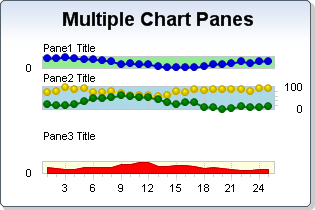
In the chart above, three series are each assigned to an individual pane. As you can see, each pane has several attributes unique to that pane instance, such as the InsideBackObject, InsideColor, Proportion, Separation and Title. Also observe how each of the panes have an independent axis.
The first indexed pane of the collection is referred to the main pane of the chart. It can be accessed by the Chart.getMainPane()property of the Chart
Class
.
| Constructor Summary | |
|---|---|
Pane()
|
|
Pane(int index)
|
|
| Method Summary | |
|---|---|
AxisYCollection |
getAxes()
Provides access to the Y Axis Collection for the selected Pane. |
AxisY |
getAxisY()
Provides access to the members of the main Y Axis for the selected Pane. |
Color |
getBackColor()
Gets the BackColor. |
IBackgroundAdornment |
getBackground()
Gets the Background. |
Rectangle |
getBoundingRectangle()
Returns a rectangle object that contains attributes for the selected pane. |
double |
getProportion()
Gets the Proportion. |
int |
getSeparation()
Gets the Separation. |
Title |
getTitle()
Gets the Title. |
boolean |
isVisible()
Gets the Visible. |
void |
setBackColor(Color value)
Sets the inside color for the selected pane. |
void |
setBackground(IBackgroundAdornment value)
Sets an ImageBackground or GradientBackground object for a pane. |
void |
setProportion(double value)
Sets a value indicating the proportional size of the selected pane. |
void |
setSeparation(int value)
Sets a value indicating the space between panes. |
void |
setTitle(Title value)
Gets the Title object for a selected pane. |
void |
setVisible(boolean value)
Sets a value indicating if the Pane object should be shown or not. |
| Methods inherited from class java.lang.Object |
|---|
equals, getClass, hashCode, notify, notifyAll, toString, wait, wait, wait |
| Constructor Detail |
|---|
public Pane()
public Pane(int index)
| Method Detail |
|---|
public AxisYCollection getAxes()
Provides access to the Y Axis Collection for the selected Pane.
Use this property to mamipulate the Y Axes of the Pane.
The getAxisY() property provides direct access to the Pane's main Y axis.
getAxisY(),
Axispublic AxisY getAxisY()
Provides access to the members of the main Y Axis for the selected Pane.
This property is a shortcut to the Pane's main AxisY.
To access any other Pane's Y axes, i.e. Secondary Y axis, use the getAxes() property.
When using Panes, the AxisY for the first Pane can be also accessed directly from the Chart object:
chart1.getPanes().get(0).getAxisY().getTitle().setText("My Y-Axis");
Below, the second pane Y axis title is set to "Y Axis (Second Pane)":
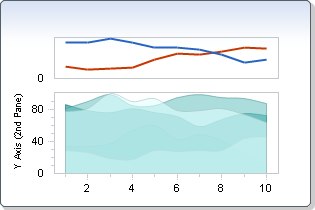
getAxes(),
AxisYpublic Color getBackColor()
Gets the BackColor. For more detail see setBackColor(java.awt.Color).
public IBackgroundAdornment getBackground()
Gets the Background. For more detail see setBackground(com.softwarefx.chartfx.server.adornments.IBackgroundAdornment).
public Rectangle getBoundingRectangle()
Returns a rectangle object that contains attributes for the selected pane.
By reading the attributes of the Rectangle object returned by this property, you can determine the size and location of a selected pane object.
setBackground(com.softwarefx.chartfx.server.adornments.IBackgroundAdornment),
setBackColor(java.awt.Color),
setProportion(double),
setSeparation(int),
setTitle(com.softwarefx.chartfx.server.Title),
Chart,
AxisYpublic double getProportion()
Gets the Proportion. For more detail see setProportion(double).
public int getSeparation()
Gets the Separation. For more detail see setSeparation(int).
public Title getTitle()
Gets the Title. For more detail see setTitle(com.softwarefx.chartfx.server.Title).
public boolean isVisible()
Gets the Visible. For more detail see setVisible(boolean).
public void setBackColor(Color value)
Sets the inside color for the selected pane.
For more information regarding the Color type, please refer to your Java API documentation.
For gradient background, see the setBackground(com.softwarefx.chartfx.server.adornments.IBackgroundAdornment).
Named colors are supported (e.g. Red), to use Hex notation you have to use quotes (e.g. "#FF00FF").
Below, the second pane back color is set to dark blue:
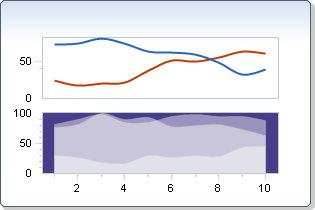
setBackground(com.softwarefx.chartfx.server.adornments.IBackgroundAdornment),
Chart,
AxisYpublic void setBackground(IBackgroundAdornment value)
Sets an ImageBackground or GradientBackground object for a pane.
Each pane present in a chart may have a unique ImageBackground or GradientBackground object configured as the background.
Please see the ImageBackground and GradientBackground objects for information regarding supported members.
ImageBackground,
GradientBackgroundpublic void setProportion(double value)
Sets a value indicating the proportional size of the selected pane.
This property accepts an integer that specifies the "proportional" size of a selected pane. For Example, If you set this property to a value of 2, that pane's height would be twice the size of any default pane's height. The default pane size will depend on the number of panes visible in the chart as well as the dimensions of the chart object itself.
Below, the second pane proportion is set to 3:
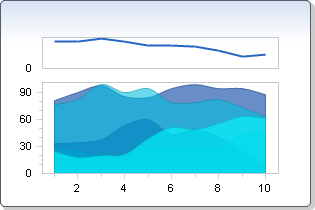
setBackground(com.softwarefx.chartfx.server.adornments.IBackgroundAdornment),
setBackColor(java.awt.Color),
setSeparation(int),
setTitle(com.softwarefx.chartfx.server.Title),
Chart,
AxisYpublic void setSeparation(int value)
Sets a value indicating the space between panes.
This property is useful when multiple panes are configured and you need to create space for readability.
Below, the second pane separation is set to 60:
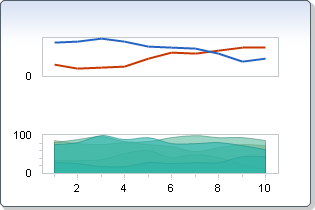
Chart,
AxisYpublic void setTitle(Title value)
Gets the Title object for a selected pane.
This property returns a Title object. By accessing the title Class members you will be able to control attributes such as: Alignment, Color, Font,Text, etc.
Each pane may only have one title.
The setSeparation(int) property may be used to control the space between panes. This may be useful to developers trying a change the font for a pane's title.
Below, the second pane title is set to "Second Pane":
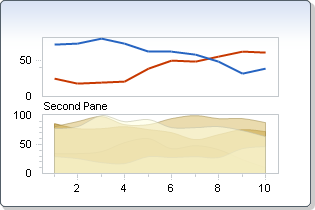
setSeparation(int),
Title,
TitleDockable,
Chart,
AxisYpublic void setVisible(boolean value)
Sets a value indicating if the Pane object should be shown or not.
Hiding a Pane object will hide all the series associated with that pane, not only from the chart area but also from the Legend and the DataGrid. The hidden series objects will remain accessible but invisible.
Hiding a Pane object does not destroy or lose previous settings assigned by other properties.
|
http://www.softwarefx.com | |||||||
| PREV CLASS NEXT CLASS | FRAMES NO FRAMES | |||||||
| SUMMARY: NESTED | FIELD | CONSTR | METHOD | DETAIL: FIELD | CONSTR | METHOD | |||||||